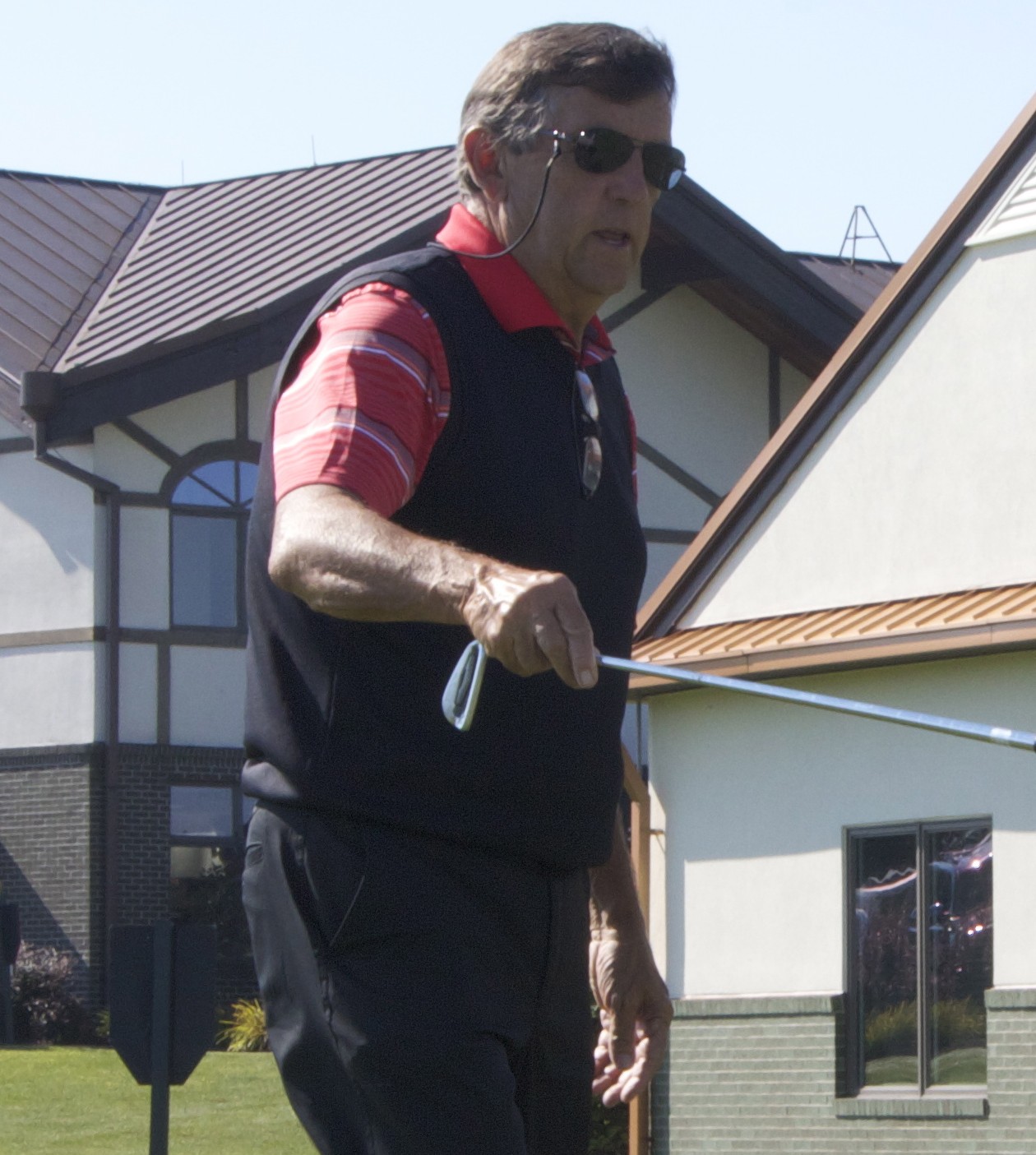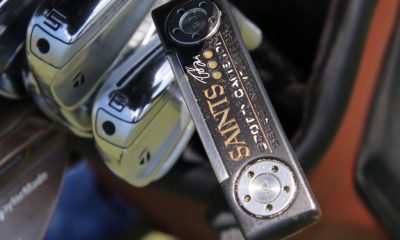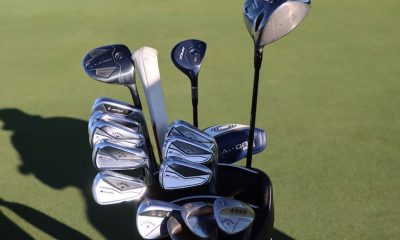Instruction
Dennis Clark: Helping golfers find their own path

Ask a handful of golf instructors to analyze a golfer’s swing and you will likely get a handful of different answers. It’s the nature of golf instruction – different teachers have found different answers to the question of how to best hit a golf ball toward a target.
Some golf instructors advocate certain methods and fundamentals, while others have pointed to the laws of physics and biomechanics as the basis of their teaching. Then there are teachers like Dennis Clark, an instructor who doesn’t promote any specific golf swing or methodology.
Clark, a PGA Master Professional, relies on the experience of the more than 30,000 lessons he’s given in his 25-year career as the foundation for his instruction. He is director of instruction at Nemacolin Woodlands Resort in Farmington, Penn., the site of the 84 Lumber Classic from 2003 to 2006, and has taught golfers of all levels from very beginners to tour pros. He was heavily influence by legendary English golf instructor John Jacobs, one of the first teachers to advocate the observation of ball flight as the key to successful coaching.
There are very few training aids at Clark’s teaching facility, because according to Clark there is only one thing great golfers have in common: their swings return the club to the same position at impact time after time. Training aids can help golfers alleviate certain flaws while using the aid, but Clark rarely sees much of a carry over when he puts their golf clubs back in their hands.
[youtube id=”OWRyyYBIaw0″ width=”600″ height=”350″]
While the 63-year-old teaching veteran identifies himself as being anti-method, he is certainly not anti-technology. Every lesson he gives employs high-speed video and a golf Doppler radar system (Clark uses Trackman) to help him learn as much as possible about his student’s swing.
According to Clark, golf Doppler radar systems have ushered in a new era of understanding for golf teaching professionals, what Clark calls an age of enlightenment for golf instruction. Thanks to these technologies, instructors know more about what the golf club is doing at impact than ever before.
The latest technology, however, tends to perform best in the hands of the most experienced professionals, which is why Clark said that there is no substitute for the knowledge he’s gained from nearly three decades on the lesson tee.
In the past, it had been typical for an established instructor like Clark to take on a starting pro and teach him his craft. But Clark has seen a trend developing in the golf teaching industry – there are fewer one-on-one learning situations for starting pros. Retail and management training often take away from a beginning instructor’s time on the lesson tee as well, but even with these added responsibilities many young teaching professionals are leaving the mentoring process as soon as they can to go out on their own as instructors.
“If you’re only popping your head out of the pro shop for five to 10 hours a week to give lessons, you’re not being exposed to enough situations to go out on your own. [Young golf instructors] leave, they think they have it, but they don’t.
Clark’s background
Clark grew up in Southern Philadelphia, a scene much different than the AAA Five-Diamond resort that he currently occupies during Southwestern Pennsylvania’s golf season and the Marco Island Marriot Resort where he teaches from November to April in Naples, Fla. His underprivileged upbringing made a career in golf unlikely, but he fell in love with the game regardless. He was introduced to golf as a caddie, playing as many as 90 holes on Mondays when caddies were allowed to play the course.
*Clark’s teaching facility at Nemacolin Woodlands Resort
As he got better, he took lessons, although he never considered himself good enough to turn professional. Clark was a good basketball player — talented enough to play in high school as well as in college at Glassboro State. But even though his focus was on basketball, he continued to play golf in the summers. He did so “quietly,” however; golf was not a sport he would brag about to his peers.
After college, Clark worked as a schoolteacher, which allowed him free time to play golf in the summers. He also worked restaurant jobs and continued to caddy, jobs that led to free afternoons and free golf. Clark’s skills improved, but even as they did he was reluctant to pursue a career playing golf. But he thought a career teaching golf might be feasible if he combined his background in education with his passion for golf.
Clark earned his PGA Professional card with a single focus. The operations side of golf wasn’t for him — he only wanted to teach people how to play golf, and spent his early years developing an eye for the swing and honing his communication skills. He refined these skills teaching long days in the John Jacobs Golf Schools and Golf Digest Schools. But when Clark started out, he made the same mistakes as most beginning teaching pros. He taught his students the things he did to hit the ball well.
Clark told me a story about a lesson he had very early in his career with a man that was occasionally shanking his wedges. Clark never had the shanks himself, so he wasn’t experienced at solving the problem. Clark told the man everything he knew about curing the shanks. He instructed him to move away from the ball, to get his weight more on his heels – anything to keep the man from swinging the heel of the club out toward the ball on the downswing. But what Clark didn’t tell the man was the actual cause of the shanks – a shank happens when the ball is struck off the hosel of the club.
Before long, the man wasn’t just shanking his shots occasionally; he was shanking nearly all of his shots. Clark apologized to the man, saying he was new at teaching and really hadn’t earned his stripes yet. As Clark was walking away the man told Clark not to worry about it, “He would figure out how to stop hitting the ball off the toe of the club eventually.”
Clark realized his mistake, telling the man that he had it wrong — a shank happens when a golfer does the exact opposite, making contact well toward the heel of the club.
“Why didn’t you tell me that in the first place?” the man asked.
It was an important lesson for Clark. He realized that a simple explanation is often the best. And his choice of words would be very important when teaching golf, especially to high-handicap players.
On the lesson tee with Dennis Clark
I took a lesson from Clark before I interviewed him at Nemacolin Woodlands Resort in late July. I had just finished playing a three-day amateur event where I had hit some very good shots, but also some very bad ones. Like every golfer, I wanted to know what was causing my bad shots, and what I could do to fix them.
Although Clark and I had been working together on instructional stories since April, it was the first time I had the chance to meet him in person. Like most of the readers that commented on his stories, I’d enjoyed his content. Click here for a list of Clark’s instruction stories. I was anxious to hear what he would say about my swing.
Taking a lesson can be an uneasy experience, but it was hard not be at ease at Nemacolin. The resort is located on 2,800 acres in the mountains of Southwestern Pennsylvania, about 1.5 hours south of Pittsburgh and 45 minutes away from any city that can be called a small town. But Joe Hardy, the owner of 84 Lumber and the founder of Nemacolin Woodlands, made sure there are countless attractions that make the resort’s isolation a non-factor.
The resort has a spa (one for humans, one for pets), a zoo that includes exotic animals such as lions and zebras, a 140-acre outdoor sporting facility for shooting and fly fishing, fine dining and quite a few other draws. But like most addicted golfers, I was most excited by the opportunity to improve my golf game.
It didn’t take long for Clark to recognize the recurring flaws in my swing. After a handful of 6 irons, Clark led me inside his studio to watch high-speed video of my swing on his V1 Golf Academy software. He showed me that during my downswing I had a “reverse twist” of the clubface; instead of the clubface rotating closed, my clubface was actually opening as it approached the ball. Close to impact, I was forced to roll the face shut in an attempt to square the clubface. Clark’s Trackman showed that many times I failed – my clubface was opened at impact sending shots to the right, the same misses I battled in my tournament.
To fix the problem, Clark had me hit shots where I felt like the clubface was rotating more closed during my downswing. This change was twofold – it eliminated the need for me to roll the club shut at impact, and because this created less hand action my body rotation also improved. The best part about the change was that it took only a few swings for me to start incorporate the changes Clark proposed. Less than 24 hours later I played Mystic Rock, a Pete Dye design on the Nemacolin property that hosted the 84 Lumber Classic and played a solid round working on the swing changes.
*No. 1 at the Pete Dye-designed Mystic Rock at Nemacolin Woodlands Resort
“It never gets old”
During my lesson, Clark emphasized the need for me to turn my upper body more behind the golf ball in the backswing, eliminating a reverse pivot in my lower body. When I watched him give lessons to a six handicap, however, he taught the exact opposite, having the golfer feel that he stayed on his left side during the backswing.
The reason Clark gave two contradictory lessons is simple. I tended to contact the golf ball “late,” hitting my shots thin, while the man from Clark’s other lesson tended to hit the ball early, shallowing out too soon and hitting the ball fat.
“His swing had never bottomed out in front of the ball in his life,” Clark said. “As soon as I got him to do that, he was hitting much better shots.”
To Clark, it is an absolute requirement that a student leaves the lesson hitting the ball better than when they arrived – it’s the way that he can best promote the game of golf.
“Most people quit [golf] or don’t play as much because the game gets frustrating to them,” Clark said. “I find that when they start hitting it a little better, they play more. And I owe everything to golf, so why not give something back?”
To best promote the game, he can’t teach everyone the same way because every golfer’s swing is different. That’s why Clark has become so excited about golf Doppler teaching systems like his Trackman. They provide an avenue for further learning and understanding, and have helped Clark become a better teacher. Even more importantly, golf Doppler radar systems have provided information that in some cases has been contradictory to what some golf experts regard as truth.
For example, instructors not using a golf Doppler radar system might assume that a ball that started left of the target and moved to the right (for a right-handed golfer) did so because the club was moving on an out-to-in path at impact. While this is often the case, sometimes it is not.
Golf Doppler radar has shown that for every 0.5 inches a golfer (right-handed in this example) hits a ball toward the heel of the club, a counter-clockwise (or closing) rotation of 2.5 degrees occurs in the clubface. So a golfer could actually have an in-to-out path at impact, the type of movement that is typically associated with draw, and hit a fade. The same is true of a toe strike – a golfer could swing out-to-in, the type of move associated with a fade, and with toe contact he or she could hit a draw.
Clark said that if I came to his lesson tee for six hours, I would see six different lessons. That’s why after more than 25 years teaching golf, he still hasn’t tired of his job.
“Every lesson is a little different,” Clark said. “A different puzzle that I have to solve.”
Students who overload on instruction articles and videos sometimes complicate that puzzle. While Clark has found truth in nearly all the articles and videos he has seen, he said that the average golfer doesn’t know what tips apply to them. This can do more harm than good to their golf games. That’s why Clark maintains that he doesn’t teach golf, he teaches people to play golf.
“When some golfers take their first lesson from me, they think I’m giving them a Band-Aid fix because they start hitting the ball better in 10 minutes,” Clark said. “But it’s not a Band-Aid. I’m just starting them on the path to making a better swing within their limits.”
Click here for discussion in the “Instruction & Academy” forum.
You can follow Zak on Twitter @ZakKoz and GolfWRX @GolfWRX
- LIKE2
- LEGIT0
- WOW0
- LOL0
- IDHT1
- FLOP0
- OB0
- SHANK0
Instruction
Clement: Laid-off or perfect fade? Across-the-line or perfect draw?

Some call the image on the left laid off, but if you are hitting a fade, this could be a perfect backswing for it! Same for across the line for a draw! Stop racking your brain with perceived mistakes and simply match backswing to shot shape!
- LIKE0
- LEGIT0
- WOW0
- LOL0
- IDHT0
- FLOP0
- OB0
- SHANK1
Instruction
The Wedge Guy: The easiest-to-learn golf basic

My golf learning began with this simple fact – if you don’t have a fundamentally sound hold on the golf club, it is practically impossible for your body to execute a fundamentally sound golf swing. I’m still a big believer that the golf swing is much easier to execute if you begin with the proper hold on the club.
As you might imagine, I come into contact with hundreds of golfers of all skill levels. And it is very rare to see a good player with a bad hold on the golf club. There are some exceptions, for sure, but they are very few and very far between, and they typically have beat so many balls with their poor grip that they’ve found a way to work around it.
The reality of biophysics is that the body moves only in certain ways – and the particulars of the way you hold the golf club can totally prevent a sound swing motion that allows the club to release properly through the impact zone. The wonderful thing is that anyone can learn how to put a fundamentally sound hold on the golf club, and you can practice it anywhere your hands are not otherwise engaged, like watching TV or just sitting and relaxing.
Whether you prefer an overlap, interlock or full-finger (not baseball!) grip on the club, the same fundamentals apply. Here are the major grip faults I see most often, in the order of the frequency:
Mis-aligned hands
By this I mean that the palms of the two hands are not parallel to each other. Too many golfers have a weak left hand and strong right, or vice versa. The easiest way to learn how to hold the club with your palms aligned properly is to grip a plain wooden ruler or yardstick. It forces the hands to align properly and shows you how that feels. If you grip and re-grip a yardstick several times, then grip a club, you’ll see that the learning curve is almost immediate.
The position of the grip in the upper/left hand
I also observe many golfers who have the butt of the grip too far into the heel pad of the upper hand (the left hand for right-handed players). It’s amazing how much easier it is to release the club through the ball if even 1/4-1/2″ of the butt is beyond the left heel pad. Try this yourself to see what I mean. Swing the club freely with just your left hand and notice the difference in its release from when you hold it at the end of the grip, versus gripping down even a half inch.
To help you really understand how this works, go to the range and hit shots with your five-iron gripped down a full inch to make the club the same length as your seven-iron. You will probably see an amazing shot shape difference, and likely not see as much distance loss as you would expect.
Too much lower (right) hand on the club
It seems like almost all golfers of 8-10 handicap or higher have the club too far into the palm of the lower hand, because that feels “good” if you are trying to control the path of the clubhead to the ball. But the golf swing is not an effort to hit at the ball – it is a swing of the club. The proper hold on the club has the grip underneath the pad at the base of the fingers. This will likely feel “weak” to you — like you cannot control the club like that. EXACTLY. You should not be trying to control the club with your lower/master hand.
Gripping too tightly
Nearly all golfers hold the club too tightly, which tenses up the forearms and prevents a proper release of the club through impact. In order for the club to move back and through properly, you must feel that the club is controlled by the last three fingers of the upper hand, and the middle two fingers of the lower hand. If you engage your thumbs and forefingers in “holding” the club, the result will almost always be a grip that is too tight. Try this for yourself. Hold the club in your upper hand only, and squeeze firmly with just the last three fingers, with the forefinger and thumb off the club entirely. You have good control, but your forearms are not tense. Then begin to squeeze down with your thumb and forefinger and observe the tensing of the entire forearm. This is the way we are made, so the key to preventing tenseness in the arms is to hold the club very lightly with the “pinchers” — the thumbs and forefingers.
So, those are what I believe are the four fundamentals of a good grip. Anyone can learn them in their home or office very quickly. There is no easier way to improve your ball striking consistency and add distance than giving more attention to the way you hold the golf club.
More from the Wedge Guy
- The Wedge Guy: Golf mastery begins with your wedge game
- The Wedge Guy: Why golf is 20 times harder than brain surgery
- The Wedge Guy: Musings on the golf ball rollback
- LIKE86
- LEGIT13
- WOW6
- LOL1
- IDHT0
- FLOP4
- OB1
- SHANK8
Instruction
Clement: Stop ripping off your swing with this drill!

Not the dreaded headcover under the armpit drill! As if your body is defective and can’t function by itself! Have you seen how incredible the human machine is with all the incredible feats of agility all kinds of athletes are accomplishing? You think your body is so defective (the good Lord is laughing his head off at you) that it needs a headcover tucked under the armpit so you can swing like T-Rex?
- LIKE0
- LEGIT2
- WOW2
- LOL0
- IDHT0
- FLOP0
- OB0
- SHANK2
-

 19th Hole2 weeks ago
19th Hole2 weeks agoDave Portnoy places monstrous outright bet for the 2024 Masters
-

 19th Hole4 days ago
19th Hole4 days agoJustin Thomas on the equipment choice of Scottie Scheffler that he thinks is ‘weird’
-

 19th Hole2 weeks ago
19th Hole2 weeks agoTiger Woods arrives at 2024 Masters equipped with a putter that may surprise you
-

 19th Hole3 days ago
19th Hole3 days ago‘Absolutely crazy’ – Major champ lays into Patrick Cantlay over his decision on final hole of RBC Heritage
-

 19th Hole2 weeks ago
19th Hole2 weeks agoTwo star names reportedly blanked Jon Rahm all week at the Masters
-

 19th Hole1 week ago
19th Hole1 week agoReport: LIV Golf identifies latest star name they hope to sign to breakaway tour
-

 19th Hole2 weeks ago
19th Hole2 weeks agoNeal Shipley presser ends in awkward fashion after reporter claims Tiger handed him note on 8th fairway
-

 19th Hole1 week ago
19th Hole1 week agoBrandel Chamblee has ‘no doubt’ who started the McIlroy/LIV rumor and why


















dennis clark
Sep 29, 2012 at 10:57 pm
Thx for the kind words Kevin; glad you’re enjoying the articles.
Kevin Downer
Sep 25, 2012 at 3:39 pm
I have had the privilege of working for and with DC. His wisdom of teaching people to play golf is remarkable and is equaled by his passion and knowledge not only associated with teaching golf but all aspects of the game from its history through the business side of the game. I learned from him not only ways to improve my game but also how the business operates and most importantly from his stories which in addition to being entertaining provided great life lessons. Thanks for being a great mentor and friend DC.God Bless!
WVUfore
Sep 16, 2012 at 2:14 pm
Your golf knowledge will increase with every strike you make. I have had the priviledge of receiving instruction and golf history lessons both from Mr Clark. Unfortunately I am not a single handicap, but each round played in the presence of DC I received SCRATCH instruction.
Pingback: GolfWRX.com – Dennis Clark: Helping golfers find their own path | Golf Grip Instruction
joe the pro
Sep 8, 2012 at 11:06 am
DC is a GREAT teacher; fastest to diagnose and correct I’ve ever seen.
Turn&Release
Sep 7, 2012 at 2:16 pm
I have been a student of Dennis Clark for many years. He has been amazing for game and my knowledge of Golf. Not only has he turned me into low single digit handicap, but he increased my knowledge in golf history, rules, and (most of all) my own swing. After working with Dennis, even one time, anybody will know 10 times more about their personal golf swing then they did before. He is the best teacher I have ever met and I would recomend him for instuction to all players at all levels. Thank you Dennis!!!